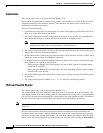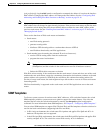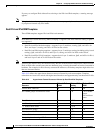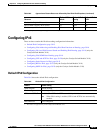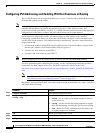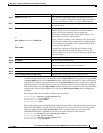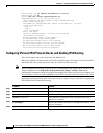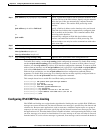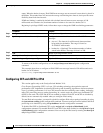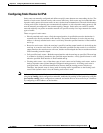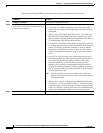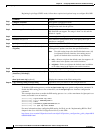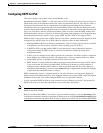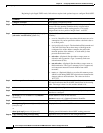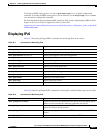
39-20
Cisco Catalyst Switch Module 3110 and 3012 for IBM BladeCenter Software Configuration Guide
OL-12189-01
Chapter 39 Configuring IPv6 Host Functions and Unicast Routing
Configuring IPv6
empty. When the bucket is empty, IPv6 ICMP error messages are not sent until a new token is placed in
the bucket. This method does not increase the average rate-limiting time interval, but it provides more
flexibility than fixed-time intervals.
ICMP rate limiting is enabled by default with a default interval between error messages of 100
milliseconds and a bucket size (maximum number of tokens to be stored in a bucket) of 10.
Beginning in privileged EXEC mode, follow these steps to change the ICMP rate-limiting parameters:
To return to the default configuration, use the no ipv6 icmp error-interval global configuration
command.
This example shows how to configure an IPv6 ICMP error message interval of 50 milliseconds and a
bucket size of 20 tokens.
Switch(config)# ipv6 icmp error-interval 50 20
Configuring CEF and dCEF for IPv6
This section applies only to the Catalyst Switch Module 3110.
Cisco Express Forwarding (CEF) is a Layer 3 IP switching technology that optimizes network
performance. CEF implements an advanced IP look-up and forwarding algorithm to deliver maximum
Layer 3 switching performance. It is less CPU-intensive than fast-switching route-caching, dedicating
more CPU processing power to packet forwarding. In a switch stack, the switch uses distributed CEF
(dCEF) in the stack. IPv4 CEF and dCEF are enabled by default. IPv6 CEF and dCEF are disabled by
default, but are automatically enabled when you configure IPv6 routing.
To route IPv6 unicast packets, you must first globally configure IPv6 unicast packet forwarding by using
the ipv6 unicast-routing global configuration command. You must configure an IPv6 address and IPv6
processing on an interface by using the ipv6 address interface configuration command.
To disable IPv6 CEF or distributed CEF, use the no ipv6 cef or no ipv6 cef distributed global
configuration command. To reenable IPv6 CEF or dCEF if it has been disabled, use the ipv6 cef or ipv6
cef distributed global configuration command. You can verify the IPv6 state by entering the show ipv6
cef privileged EXEC command.
Command Purpose
Step 1
configure terminal Enter global configuration mode.
Step 2
ipv6 icmp error-interval interval [bucketsize] Configure the interval and bucket size for IPv6 ICMP error
messages:
• interval—The interval (in milliseconds) between tokens
being added to the bucket. The range is from 0 to
2147483647 milliseconds.
• bucketsize—(Optional) The maximum number of tokens
stored in the bucket. The range is from 1 to 200.
Step 3
end Return to privileged EXEC mode.
Step 4
show ipv6 interface [interface-id] Verify your entries.
Step 5
copy running-config startup-config (Optional) Save your entries in the configuration file.



